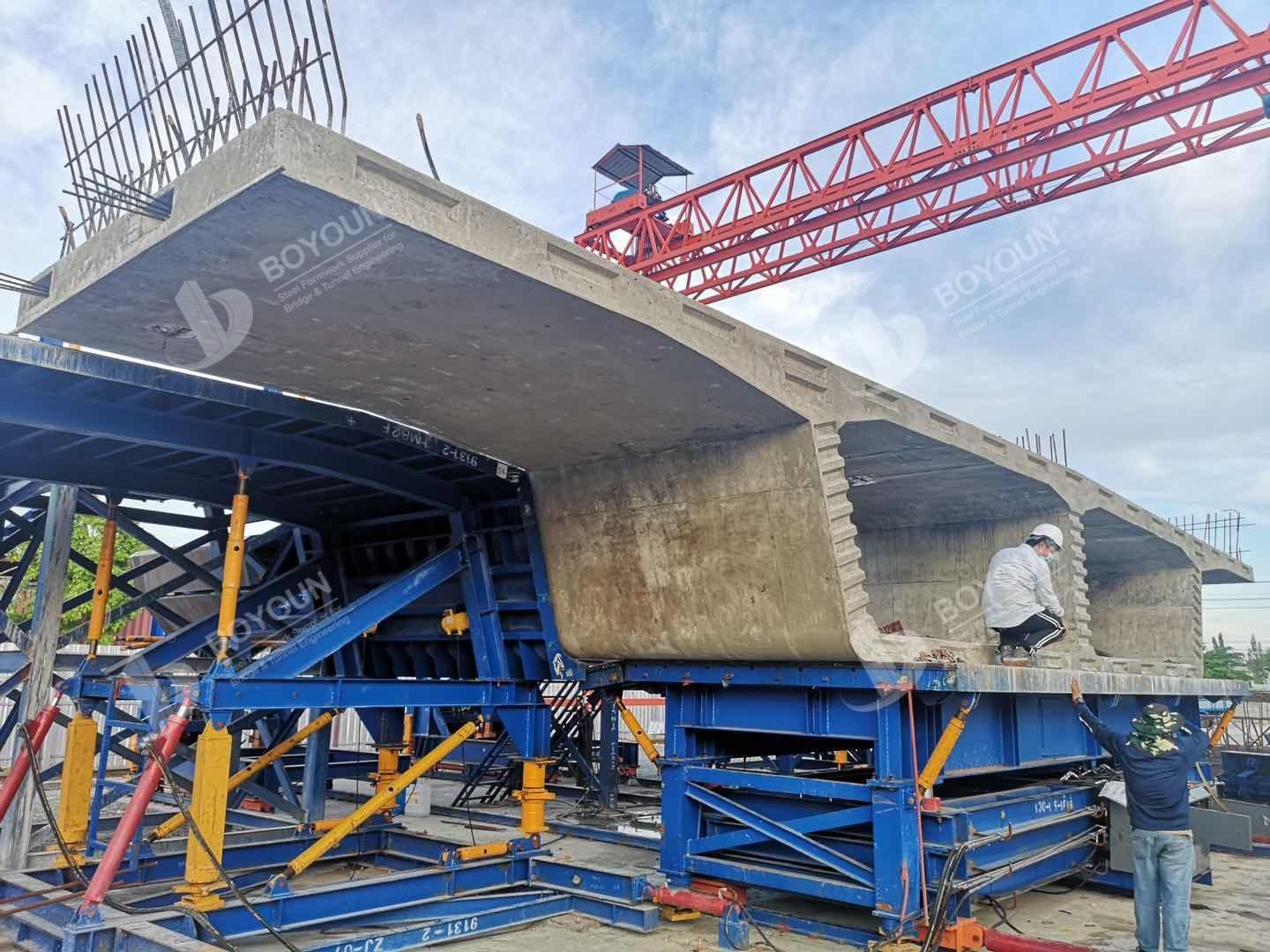(1) Problem and Analysis
Assembly misalignment can be categorized into two types:
Insufficient Temporary Fixation of Prefabricated Pier-Top Segments
In the span-by-span assembly process, due to insufficient temporary fixation of prefabricated pier-top segments, as shown in the diagram, factors such as jack oil return, bridge girder launcher spanning, and uneven finishing of prefabricated cross slopes may cause positional changes of pier-top segments, thereby affecting the assembly accuracy of subsequent prefabricated segments.
Misalignment in Wide Girder Assembly Segments
During the prefabrication and assembly of wide girders, non-elastic deformation of segments during storage, installation accuracy of pier-top segments during installation, and the thickness of adhesive between segments have significant impacts on the elevation of wide girders in the maximum cantilever state. Additionally, temperature effects, material properties of main girders, and asymmetric temporary loads also affect the maximum cantilever state, reducing assembly accuracy and easily causing misalignment.
(2) Solutions
During the prefabrication and assembly stage, enhance the fixation of prefabricated segments and add temporary constraints if necessary. Meanwhile, strengthen monitoring of easily disturbed segments, promptly correct displacements caused by external factors, and ensure installation accuracy.
For wide girders, during prefabrication, adjust matching girders according to prefabrication instructions, improve measurement accuracy, and control errors; properly cure concrete after pouring; ensure storage pedestals are flat with all load-bearing supports on the same plane; during segment installation, adjust pier-top segments to minimize errors.

2. Uneven Adhesive Layer Thickness
(1) Problem and Analysis
Due to manual application and assembly alignment adjustments, the adhesive layer thickness across the entire joint section is difficult to uniform, which affects joint durability. According to adhesive thickness test results from a project, local measurements can reach 7-8mm, exceeding the design thickness of 3mm.
(2) Solutions
Improve the adhesive application method and enhance prefabrication and assembly accuracy.
3. Color Difference
(1) Problem and Analysis
Surface color differences easily occur between different prefabricated segments, mainly caused by: rusting of prefabricated steel formwork, insufficient curing of prefabricated components, poor curing conditions, and carbonation of surface concrete during storage of prefabricated girders. The color difference of prefabricated girders is shown in the diagram.
(2) Solutions
Regularly clean and derust formwork to ensure pouring quality of prefabricated segments; improve curing conditions; minimize age differences between adjacent segments; take protective measures during storage; perform appearance repair after assembly.
4. Cracks in Wide Segmental Girders During Storage
(1) Problem and Analysis
Longitudinal cracks occur in wide box girder segments during storage, particularly at the center of the bottom plate and chamfers inside the box, affecting structural durability.
Taking a wide bridge as an example, standard segments are stored with three-point support. Under this storage scheme, some prefabricated box girders developed cracks during storage.
(2) Solutions
According to the lateral force characteristics of segmental girders, measures such as adding elastic cushions, steel strands, or ordinary steel bars can be adopted to improve the anti-cracking capacity.
5. Excessive Reserved Holes in Box Cells
(1) Problem and Analysis
Temporary prestressing tension is usually required during segmental prefabrication and assembly. The current steel tooth block scheme requires reserved anchoring holes in the top and bottom plates of box girders.
(2) Solutions
The number of temporary holes in box girders can be significantly reduced by changing temporary anchoring methods, such as using concrete anchoring blocks and shear cones.
6. Inadequate Sealing of Joints
(1) Problem and Analysis
The sealing measure for prestressed pipe joints in short-line prefabricated bridges is to install rubber (closed-cell polyethylene foam) gaskets at pipe openings, but the sealing effect is unsatisfactory, leading to grout leakage, which affects bridge assembly quality.
(2) Solutions
Adopt a new type of prestressed pipe sealing device for joints, consisting of five components: cylindrical part, positioning ring, sealing ring, pushing ring, and cap. During prefabrication, connect the ring core to the rear end of the corrugated pipe in the previous segment, sleeve the positioning ring on the cylindrical part for tight combination, and pass the cylindrical part through the limiting hole of the rear formwork with the positioning ring closely fitting the hole. During assembly, sleeve the pushing ring and sealing ring on the cylindrical part of the previous segment, and fasten the cap of the next segment to the cylindrical part, so that the sealing ring slides along the conical section and the second cylindrical section under the push of the pushing ring, expanding and deforming to seal the space between the cap and the second cylindrical section, achieving precise positioning of corrugated pipes.
7. Durability Risks of Joints
(1) Problem and Analysis
Joint durability depends on the quality of concrete near joints and the durability of joint adhesive. Prefabricated joints are weak sections of assembled bridges, requiring high-quality concrete to provide sufficient resistance. Meanwhile, joint adhesive is prone to performance degradation due to long-term exposure to air and sunlight.
(2) Solutions
For concrete quality at joints: strictly follow mix proportions during pouring, control raw material quality, ensure full vibration during pouring, and strengthen curing control in subsequent maintenance.
For adhesive durability:
1) Currently, grade A adhesive is used. In terms of long-term durability, product standards require that the reduction rate of tensile shear strength after 90-day damp-heat aging should be ≤10%, which effectively solves the problem of significant mechanical property degradation due to aging.
2) According to joint structure characteristics, only the structural adhesive along the outer contour of the joint section is exposed to sunlight for a long time, while most structural adhesive is in a relatively closed environment, ensuring its durability.
Quality issues of short-segment prefabricated bridges include assembly misalignment, uneven adhesive thickness, color difference, cracks during storage, excessive holes, and joint sealing problems. Effective solutions have been developed for each type of issue. With the continuous improvement of industrial production and assembly technology, prefabricated segmental girders have more controllable quality and better performance compared to cast-in-place girders.

International Department: Room 2507-2508, Tower C of Wanda Plaza, Tongzhou District, Beijing 101118, China.
+86-13021287080
info@boyoun.cn